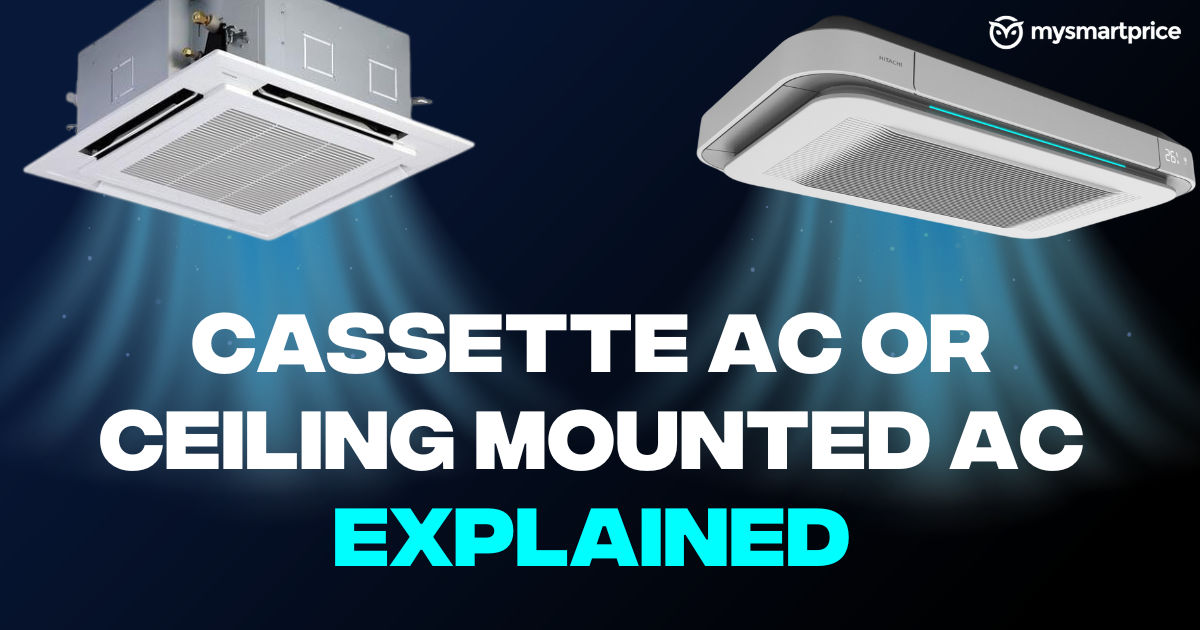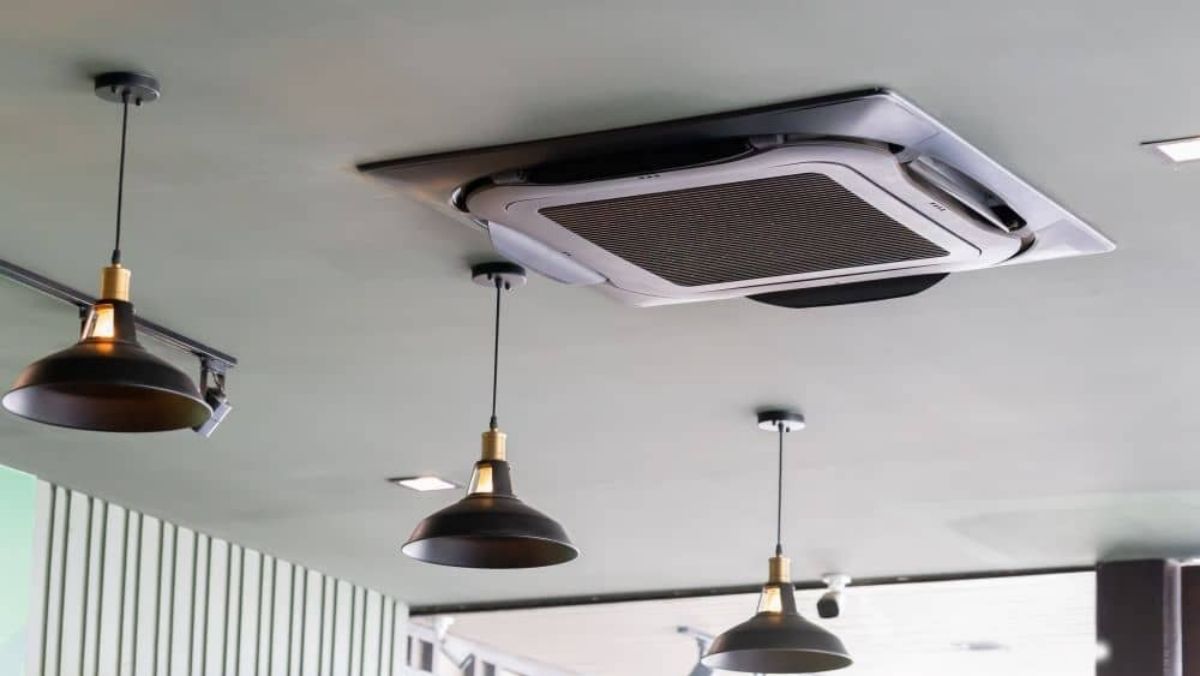
Cassette air conditioners, also known as ceiling-mounted air conditioners, have become increasingly popular in residential and commercial spaces. They offer a sleek design and efficient cooling capabilities. In this guide, we will explore the pros and cons of cassette ACs, understand their working, and compare them with split ACs.
Cassette AC or Ceiling Mounted AC: How They Work?
A cassette AC unit consists of two main components: an indoor unit and an outdoor unit. The indoor unit is installed flush with the ceiling, while the outdoor unit is typically placed outside the building. The mechanism is similar to a standard split AC.
The indoor unit of a cassette AC houses the condenser coil, blower fan, and air filter. Unlike regular split ACs with unidirectional airflow, a cassette AC creates an airflow in four directions. They are generally mounted in the centre of the ceiling, allowing uniform cooling throughout the room. This alignment provides more efficient cooling compared to wall-mounted split ACs.
Apart from this difference, the workings of a cassette AC are almost the same as those of a split AC. The indoor unit is connected to the outdoor unit, which contains the compressor, condenser coil, and exhaust fan.
Why are Cassette ACs used instead of Split ACs?
Although Cassette ACs and Split ACs use the same configuration of having two separate units, they have some key differences. Cassette ACs are more suitable for offices, halls, and larger spaces, while Split ACs are preferred for smaller rooms. Let’s understand why.
Cassette ACs are installed flush with the ceiling, blending seamlessly into the room’s decor and maintaining a clean aesthetic. They do not occupy additional space on walls, which is important in offices where walls are used to create shelves or storage mounts. For the same reason, split ACs can be visually obtrusive.

Airflow is another area where cassette ACs excel. They typically feature a four-way airflow design, allowing them to distribute cool air evenly in all directions. This ensures consistent cooling throughout the room and eliminates any possibility of blind spots. In contrast, split ACs usually have a single or dual airflow design, which may be less effective in larger spaces.
Capacity is yet another advantage of cassette ACs. They are generally available in higher cooling capacities than split ACs, making them ideal for larger rooms, offices, or commercial spaces where a powerful cooling solution is needed.
For comparison, split ACs are generally available in maximum capacities of two to three tons. Although higher-ton models are also in the market, they have rare applications. However, it’s normal to find cassette ACs up to 5-ton capacities.
In simple words, Cassette ACs are the perfect solution for large offices where it’s not possible to have a centralized air conditioning system. For example, if a building does not have a centralized AC, it’s easier and more efficient to have cassette ACs for an entire floor instead of having split ACs.
Advantages of Cassette AC
Cassette ACs offer several advantages over alternative cooling solutions:
- Aesthetically pleasing: Cassette ACs blend seamlessly with the ceiling, maintaining the room’s visual aesthetics without having any protruding indoor units.
- Even cooling: Their four-way airflow design ensures a uniform distribution of cool air throughout the room. When using a cassette AC, there are very few chances of left-out spots.
- Quiet operation: Cassette ACs are known for their quiet operation, providing a comfortable environment without disruptive noise.
- Energy efficient: Modern cassette ACs are equipped with inverter technology, which adjusts the compressor speed based on cooling demands, leading to significant energy savings.
- Suitable for large spaces: Cassette ACs have various cooling capacities, making them ideal for cooling large rooms, offices, or commercial spaces.
Disadvantages of Cassette AC
While cassette ACs have numerous benefits, they also come with a few drawbacks:
- Higher Cost: Cassette ACs are more expensive than split ACs due to their advanced features and installation requirements. Since they are an enterprise-oriented cooling solution, they involve higher costs compared to the competitive split AC market, where demands and availability options are higher.
- Installation complexity: Installing a cassette AC requires a higher ceiling height and may also require some modifications to the room. Due to their weight, they cannot be installed on false ceilings.
- Limited placement options: Cassette ACs can only be installed on ceilings, restricting placement options. On the other hand, split ACs or even window ACs can be installed in any corner of the room where space is available.
- Maintenance challenges: Accessing the indoor unit for cleaning and maintenance may require additional effort due to its ceiling-mounted location. Servicing cassette ACs requires more labour and manpower than split ACs.
Should you get a Cassette AC?
Cassette ACs offer a unique blend of style and functionality. A cassette AC is a strong contender if aesthetics are a priority. However, this aesthetic appeal comes at a cost, as they are typically more expensive than split ACs. They also have higher and more complicated maintenance schedules.
If you are looking for a cost-efficient cooling solution for your office or any large space, split ACs can save you a lot of money. However, due to their single-direction airflow restrictions, they won’t provide uniform cooling in all parts of the room.
Cassette ACs are worth the extra costs when considering all the factors for a large commercial space. They ensure a more comfortable environment for all people, whereas split ACs can create discomfort for individuals whose working place is near the indoor unit. Due to these reasons, cassette ACs are very common in banks, consultancy institutions, and other places.














